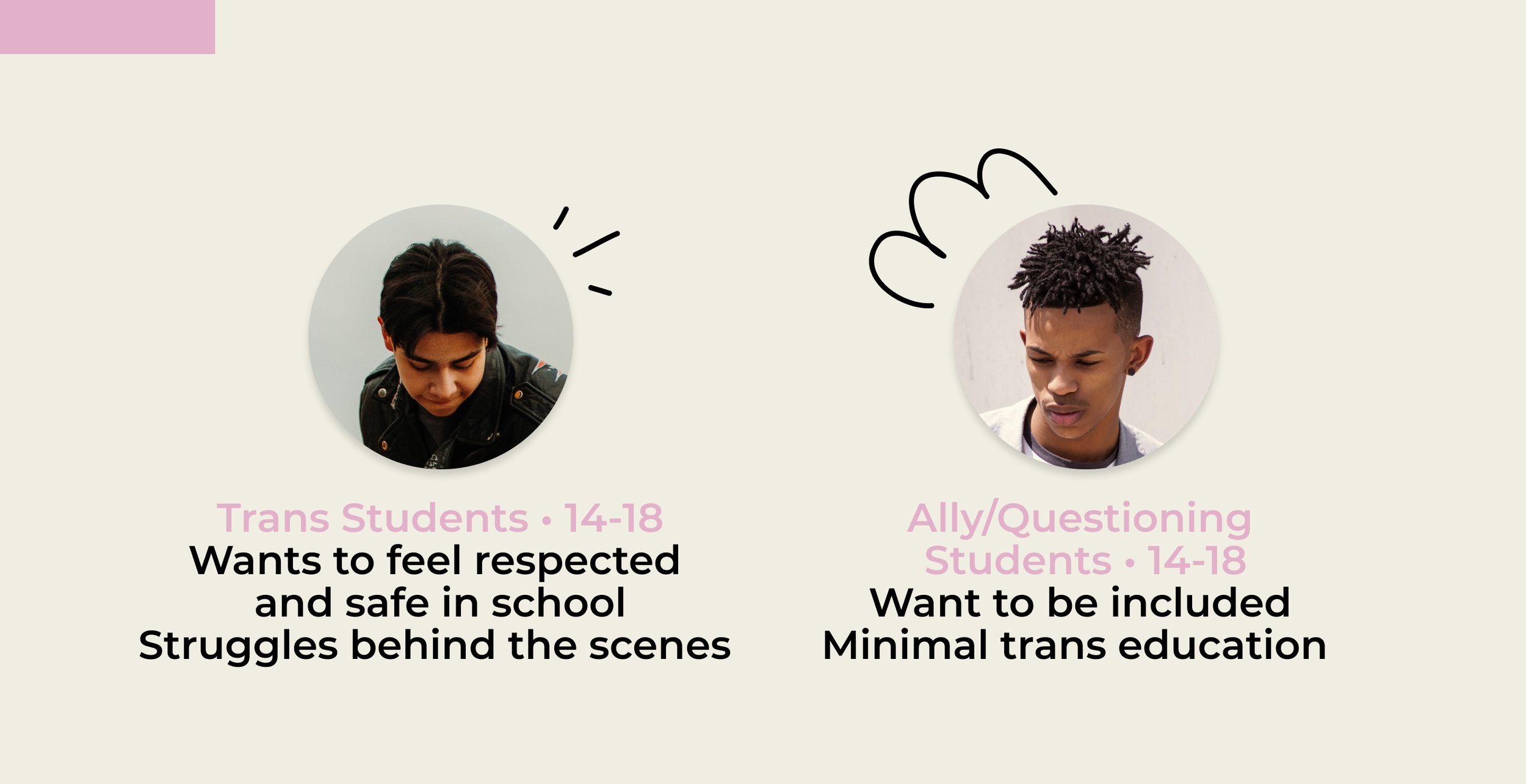
The Trans
Student Experience
Supplying Public Schools with Adequate Resources
Partnering with Trans Student Educational Resources (TSER) to create a repertoire of educational materials for trans, questioning, and ally students in public schools.
User Research
I was able to interview students who identified under the trans umbrella for this project to gather insights, and collect their stories about their experiences in public school.
UX Design
This project was designed with a focus on the experience of trans students. Throughout the design process, I used rapid iterations coupled with user testing to ensure that the end product was helpful to the end users.

EXECUTIVE SUMMARY
The Problem
Public schools are intended to be safe spaces for learning.
However, underserved students will always find it difficult
to reach the same achievements as their peers.
In today’s climate, trans students continue to face challenges
in public school. Despite these challenges, by affirming and
supporting transgender students, each person can do their part
to achieve greater gender equity in public high schools.
The Solution
Through my redesign, TSER’s tools exist as organic elements that grow with each school that utilizes them as they progress in their goal to supporting and affirming all students.
Highlights
Coming soon.

PROJECT SUMMARY
The Need
Not all public school students have access to the same resources, and though some schools want to support trans students, they may not know where to start or how to affirm and include trans-identifying students.
Trans students often have to fight for their rights and navigate safe spaces on their own. Some students may not be able to count on supportive faculty, family, or friends.
The Result
An adaptation of the TSER policy for universities for application in public high schools, as well as an update to the Gender Unicorn graphic to exist as a web-based, accessible experience.
ROLES & RESPONSIBILITIES
My Roles
UX Designer
Graphic Designer
User Researcher
Data Analyst
Copywriter

FRAMING THE PROBLEM
Problem Statement
Public schools are meant to be a safe environment that fosters learning, but that’s not the case for everyone. Trans students (including people who identify as transgender, nonbinary, gender non-conforming, genderfluid, agender and all other “non-cis” identities) often have to fight for their rights and navigate safe spaces on their own.
My solution will address this issue by creating a free repertoire
for public schools to better support their trans student population.
Hypothesis
By partnering with Trans Student Educational Resources (TSER), and creating up-to-date educational materials for trans, questioning and ally students, public schools will be able to reference a database of knowledge to help trans students feel included, valid, and safe at school.

DESIGN ARTIFACT: RESOURCE MAP
The pink-colored items indicated in the chart were areas where I felt I could design to fill a gap. The majority of these gaps fall under education, which helped guide my approach to this design.
PHASE ONE: DISCOVERY
Problem Evolution
Going to public school in Texas as an LGBTQIA+ youth is a uniquely difficult experience. Knowing the struggles first hand, I wanted to create a solution that would help make school a better experience.
In the research phase of this project I learned that my hometown high school was trying to rebuild their Pride Alliance Club and needed some pointers for getting off the ground. Thinking about this, I knew I wanted to help locally, as well as helping the broader community.
To begin, I took inventory of all the tools and resources that TSER already had available. This list was intended to find areas for improvement so I could determine where my designs would fit in.
Resource Map Analysis
The columns in the table are labeled Outreach for resources that have to do with widening the club and reaching out into the community, Action for resources that enable members to take action outside of school, and Education for resources directly related to teaching people about the trans community. Additionally, the Education column is subdivided into Workshops, Print Graphics, and Policy.
Several important things stood out to me when I was analyzing the resources; one being that while TSER provides policy recommendations for colleges, they do not have any for K-12 schools, and two being that some of their graphics have outdated information or just needed a general stylistic refresh.
DESIGN ARTIFACT: STAKEHOLDER GROUPS
Stakeholders
In order to rectify the damages caused by transphobia in school, trans students need representation and affirmation to help them feel secure and safe.
This goal may be reached in a number of ways, but the key to success is helping trans students to feel heard and respected. By including all students, teachers, and parents in the efforts to fight discrimination, we stand a greater chance of making a real change.
Informative Interviews
In order to have an accurate picture of the stakeholders for this project, I conducted interviews with students who identified under the trans umbrella, or were involved with their school’s Gay-Straight Alliance. I also interviewed with recent high-school graduates who identified under the trans umbrella and parents of trans-identifying students.
Due to the highly sensitive and personal nature of the information collected in the interviews, each respondent’s identity is kept private and they will be identified only by their age and pronouns.



